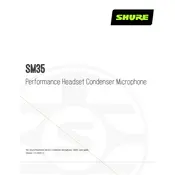Shure SM35 User Guide


To set up the Shure SM35 for live performance, first attach the headset securely to your head, ensuring the microphone boom is positioned close to your mouth. Connect the microphone to a wireless transmitter or an XLR input on a mixer using the appropriate cables. Adjust the gain levels on the mixer or transmitter to avoid distortion and feedback.
If the SM35 is not producing sound, check the cable connections to ensure they are secure. Verify that the power source for any connected wireless transmitters or mixers is functioning. Confirm that the microphone is not muted and that the gain is set to an appropriate level. If necessary, test with a different cable or input to isolate the issue.
To minimize feedback, position the speakers in front of the microphone and avoid pointing the mic directly at the speakers. Use the EQ settings on your mixer to cut frequencies that cause feedback. Additionally, ensure the microphone is positioned correctly, close to the mouth, and not too far from the sound source.
Routinely clean the microphone head and boom with a soft cloth to remove sweat and debris. Inspect cables and connectors for wear and damage, replacing them as needed. Store the microphone in a dry, safe place when not in use to prevent damage. Periodically check the headset for proper fit and adjust as necessary.
The SM35 can be used with most wireless systems that have a compatible input for the microphone's connector. However, it's important to ensure that the wireless system supports the microphone's frequency response and impedance. Consult your wireless system's manual for compatibility information.
The Shure SM35 is a condenser headset microphone designed for active performers and multi-instrumentalists. It provides clear vocal reproduction, a durable headset frame, and a flexible gooseneck for optimal positioning. The microphone also features a cardioid polar pattern to reduce background noise and feedback.
To replace the windscreen on the SM35, gently pull the existing windscreen off the microphone capsule. Align the new windscreen with the capsule and slide it on, ensuring it is securely fitted to minimize wind noise and plosive sounds during use.
If the SM35 sounds distorted, check the gain settings on your mixer or wireless transmitter to ensure they are not too high. Verify that the microphone is not too close to the mouth, which can cause distortion. If the issue persists, inspect the cable for any damage that may be affecting the signal quality.
Adjust the fit of the SM35 headset by bending the headband and boom gently to match the shape of your head and face. The headset should sit comfortably without slipping, and the microphone boom should be positioned just to the side of your mouth for optimal sound capture.
Yes, the Shure SM35 is suitable for outdoor performances. However, it is recommended to use a windscreen to reduce wind noise. Additionally, ensure the wireless system is within range and environmental conditions such as extreme temperatures or moisture are avoided to protect the equipment.